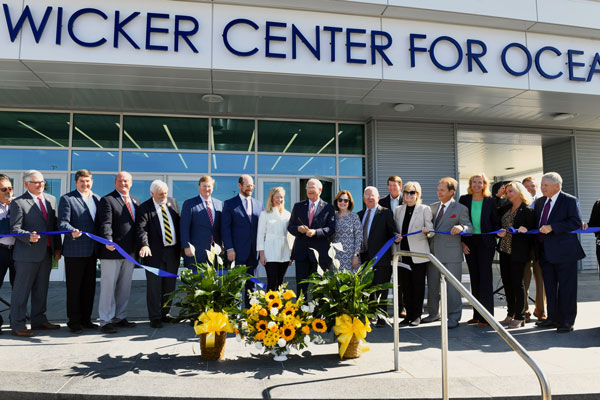Spanning 359 miles, Mississippi’s Gulf Coast is more than just a scenic stretch of shoreline. Through a combination of shipbuilding, fishing, seafood processing and maritime technologies, the Magnolia State has built one of the country’s strongest blue economies. Boasting over 4,200 companies, this ecosystem employs the third highest concentration of blue economy jobs in the nation and generated approximately $9.7 billion in gross regional product from 2018 to 2020.
Drawn by the region’s resources and talent, Ocean Aero, the creator of the world’s first wind and solar-powered autonomous underwater and surface vehicle, the Triton, relocated from San Diego, California, to Gulfport, Mississippi, around two years ago. The company officially opened its new headquarters and manufacturing facility last October, hiring 75 full-time employees.
“The talent of our employees from the Mississippi area, the support we have received from the Gulf Blue ecosystem, and the unwavering dedication of the Mississippi elected officials have exceeded our expectations in every way,” said Ocean Aero CEO Kevin Decker in a statement. “We’re honored to be citizens of the local community.”
Located at the Port of Gulfport, the new operations represent the first phase of Ocean Aero’s manufacturing expansion plans. This round will enable the production of up to 150 Tritons per year, with annex options adjacent to the facility estimated to potentially produce an additional 450 Tritons annually.
“We’re very proud of what the team has accomplished in our two years located in Mississippi and are looking forward to an even brighter future,” said Decker. “The timing couldn’t be better to add to our production base given the recent announcement of Replicator and other ongoing programs championed at both the U.S. Navy and DoD levels.”
Collaborative Efforts Charting New Waters
Since moving to Mississippi, Ocean Aero has announced a number of partnerships to advance the capabilities of maritime-related technologies.
In March 2023, the company entered into a strategic agreement with Huntington Ingalls Industries (HII), the largest military shipbuilding company in the U.S., to enhance their respective unmanned maritime platforms and autonomy software solutions. While HII is headquartered in Virginia, the company runs significant shipbuilding operations in Pascagoula, approximately 35 miles from Ocean Aero’s Gulfport headquarters.
“This is the perfect time for us to partner with HII,” said Decker. “With rising maritime challenges increasing worldwide, we need new capabilities to meet them. Incorporating our two firms’ autonomous vehicle value propositions will unlock new tools for our customers at home and abroad.”
One of Ocean Aero’s most recent collaborations includes a teaming agreement with INTRA Defense Technologies and MEMR that solidifies the three companies’ positions as key contributors to the advancement of unmanned systems in the Kingdom of Saudi Arabia. This strategic alliance was facilitated by Lockheed Martin, a significant stakeholder in Ocean Aero. Through this partnership, Ocean Aero and its collaborators will introduce disruptive maritime technology to the region, which is capable of servicing a large and growing set of applications in the Kingdom.
This project aligns with Saudi Arabia’s Vision 2030 initiative to diversify its economy and is set to promote local engineering, job creation and technology transfer.
 A ribbon-cutting was held on Friday, Oct. 13, 2023, to formally dedicate the Roger F. Wicker Center for Ocean Enterprise.
A ribbon-cutting was held on Friday, Oct. 13, 2023, to formally dedicate the Roger F. Wicker Center for Ocean Enterprise.
Photo courtesy of Kelly Dunn, USM Photo Services
359 Miles of Opportunity
To continue to fuel the development of blue tech innovations along the Gulf Coast, the University of Southern Mississippi launched the Gulf Blue Initiative, striving to bring “Big Ideas Out of the Blue” by capitalizing on the region’s geography, resources and established network of innovators.
A key aspect of this initiative is the Gulf Blue Navigator Program, which helps late-stage blue technology startups expand in the region, shorten their development timelines and accelerate their time to revenue. Throughout the four-month program, participating companies gain access to mentors, funding, state-of-the art research facilities and wet labs.
In October, USM celebrated the opening of a monumental research asset, the Roger F. Wicker Center for Ocean Enterprise. The Center is set to serve as the “centerpiece of research and development in the Gulf,” connecting the state’s major research universities, federal partners and private companies to expand the Blue Economy.
“The opening of this Center allows Southern Miss to be involved in cutting-edge ocean science and positions us as the research, innovation and economic growth gateway to the Gulf of Mexico Blue Economy,” said USM President Joe Paul. “The work done here by USM researchers will transform and advance the state’s Blue Economy. We want to thank our local, state and federal partners, and especially Senator Wicker, for helping us to make this Ocean Enterprise Center a reality.”
Located near the Port of Gulfport’s North Harbor site, the new facility allows maritime operations to have private and secure access to the Gulf of Mexico for ocean exploration, forecasting and data collection. Designed by Eley Guild Hardy Architects of Biloxi and constructed by Wharton Smith, Inc., the 62,000-sq.-ft. center was built to include administrative offices, storage areas, classrooms and laboratories to support engineering and the development of advanced technologies.
For the 2024 Gulf Cohort, USM has decided to work with companies innovating uncrewed systems. Alongside its partners NVision Solution’s Unmanned Coast and Jackson State University, USM weeded through over 260 applicants to selected six startups for this year’s cohort:
- Oscilla Power Inc.: Developing an advanced wave energy converter that can power an uncrewed vessel and unlock the tremendous renewable energy potential of the world’s oceans. (HQ: Washington)
- V2 Forensics: Developing innovations to access, extract, decrypt and parse data logs with high detail. The results are a single platform to reduce complexity and time when investigating uncrewed vessel activity as well as advance cybersecurity. (HQ: Mississippi)
- Levanta Tech: Developing a versatile drone that can float on the ocean, collect data and fly swiftly on demand. (HQ: Missouri)
- Mythos AI Inc.: Developing advanced automation and self-driving for vessels to increase the resiliency of our waterways and solve the workforce shortage. (HQ: Florida)
- BLUEiQ: Creating dual-use passive acoustic sensing to protect biodiversity, reduce effects of anthropogenic noise on marine life, and enhance ocean safety and security. (HQ: Massachusetts)
- SeaSats, Inc.: Developing high endurance, modular construction, and portability combine with a user-driven UI and easy payload integrations to create a uniquely powerful uncrewed surface vessel package. (HQ: California)
USM estimates that the program participants have the potential to generate over $17 million in economic impact and create more than 350 jobs over the next three to five years. Five of the six companies from last year’s pilot cohort remain engaged in the region. Three of the companies are working on manufacturing efforts with local industry partners and four have signed agreements with USM.

